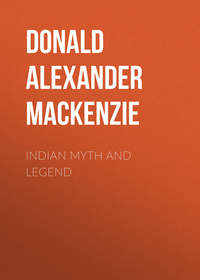 полная версия
полная версияAncient Man in Britain
The early Irish bronze forms were obviously obtained from Spain, while early English bronze forms resemble those of France and Italy. Cutting implements were the first to be introduced. This fact does not suggest that a conquest took place. The implements may have been obtained by traders. Britain apparently had in those ancient times its trading colonies, and was visited by active and enterprising seafarers.
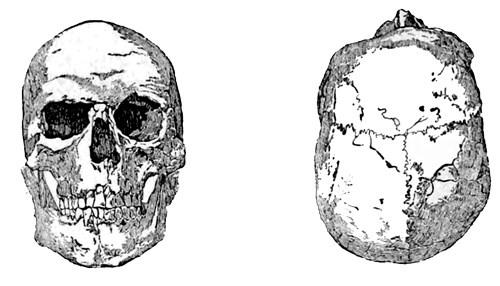
Long-head (Dolichocephalic) Skull
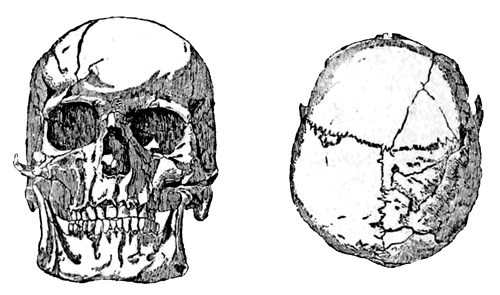
Broad-head (Brachycephalic) Skull
Both these specimens were found in "Round" Barrows in the East Riding of Yorkshire
The discovery of metals in Britain and Ireland was, no doubt, first made by prospectors who had obtained experience in working them elsewhere. They may have simply come to exploit the country. How these men conducted their investigations is indicated by the report found in a British Museum manuscript, dating from about 1603, in which the prospector gives his reason for believing that gold was to be found on Crawford Moor in Lanarkshire. He tells that he saw among the rocks what Scottish miners call "mothers" and English miners "leaders" or "metalline fumes". It was believed that the "fumes" arose from veins of metal and coloured the rocks as smoke passing upward through a tunnel blackens it, and leaves traces on the outside. He professed to be able to distinguish between the colours left by "fumes" of iron, lead, tin, copper, or silver. On Crawford Moor he found "sparr, keel, and brimstone" between rocks, and regarded this discovery as a sure indication that gold was in situ. The "mothers" or "leaders" were more pronounced than any he had ever seen in Cornwall, Somersetshire, about Keswick, or "any other mineral parts wheresoever I have travelled".63 Gold was found in this area of Lanarkshire in considerable quantities, and was no doubt worked in ancient times. Of special interest in this connection is the fact that it was part of the territory occupied by Damnonians,64 who appear to have been a metal-working people. Besides occupying the richest metal-yielding area in Scotland, the Damnonians were located in Devon and Cornwall, and in the east-midland and western parts of Ireland, in which gold, copper, and tin-stone were found as in south-western England. The Welsh Dyfneint (Devon) is supposed by some to be connected with a form of this tribal name. Another form in a Yarrow inscription is Dumnogeni. In Ireland Inber Domnann is the old name of Malahide Bay north of Dublin. Domnu, the genitive of which is Domnann, was the name of an ancient goddess. In the Irish manuscripts these people are referred to as Fir-domnann,65 and associated with the Fir-bolg (the men with sacks). A sack-carrying people are represented in Spanish rock paintings that date from the Azilian till early "Bronze Age" times. In an Irish manuscript which praises the fair and tall people, the Fir-bolg and Fir-domnann are included among the black-eyed and black-haired people, the descendants of slaves and churls, and "the promoters of discord among the people".
The reference to "slaves" is of special interest because the lot of the working miners was in ancient days an extremely arduous one. In one of his collected records which describes the method "of the greatest antiquity" Diodorus Siculus (a.d. first century) tells how gold-miners, with lights bound on their foreheads, drove galleries into the rocks, the fragments of which were carried out by frail old men and boys. These were broken small by men in the prime of life. The pounded stone was then ground in handmills by women: three women to a mill and "to each of those who bear this lot, death is better than life". Afterwards the milled quartz was spread out on an inclined table. Men threw water on it, work it through their fingers, and dabbed it with sponges until the lighter matter was removed and the gold was left behind. The precious metal was placed in a clay crucible, which was kept heated for five days and five nights. It may be that the Scandinavian references to the nine maidens who turn the handle of the "world mill" which grinds out metal and soil, and the Celtic references to the nine maidens who are associated with the Celtic cauldron, survive from beliefs that reflected the habits and methods of the ancient metal workers.
It is difficult now to trace the various areas in which gold was anciently found in our islands. But this is not to be wondered at. In Egypt there were once rich goldfields, especially in the Eastern Desert, where about 100 square miles were so thoroughly worked in ancient times that "only the merest traces of gold remain".66 Gold, as has been stated, was formerly found in south-western England, North Wales, and, as historical records, archæological data, and place names indicate, in various parts of Scotland and Ireland. During the period of the "Great Thaw" a great deal of alluvial gold must have distributed throughout the country. Silver was found in various parts. In Sutherland it is mixed with gold as it is elsewhere with lead. Copper was worked in a number of districts where the veins cannot in modern times be economically worked, and tin was found in Ireland and Scotland as well as in south-western England, where mining operations do not seem to have been begun, as Principal Sir John Rhys has shown,67 until after the supplies of surface tin were exhausted. Of special interest in connection with this problem is the association of megalithic monuments with ancient mine workings. An interesting fact to be borne in mind in connection with these relics of the activities and beliefs of the early peoples is that they represent a distinct culture of complex character. Mr. T. Eric Peet68 shows that the megalithic buildings "occupy a very remarkable position along a vast seaboard which includes the Mediterranean coast of Africa and the Atlantic coast of Europe. In other words, they lie entirely along a natural sea route." He gives forcible reasons for arriving at the conclusion that "it is impossible to consider megalithic building as a mere phase through which many nations passed, and it must therefore have been a system originating with one race, and spreading far and wide, owing either to trade influence or migration". He adds:
"Great movements of races by sea were not by any means unusual in primitive days. In fact, the sea has always been less of an obstacle to early man than the land with its deserts, mountains, and unfordable rivers. There is nothing inherently impossible or even improbable in the suggestion that a great immigration brought the megalithic monuments from Sweden to India or vice versa. History is full of instances of such migrations."
But there must have been a definite reason for these race movements. It cannot be that in all cases they were forced merely by natural causes, such as changes of climate, invasions of the sea, and the drying up of once fertile districts, or by the propelling influences of stronger races in every country from the British Isles to Japan—that is, in all countries in which megalithic monuments of similar type are found. The fact that the megalithic monuments are distributed along "a vast seaboard" suggests that they were the work of people who had acquired a culture of common origin, and were attracted to different countries for the same reason. What that attraction was is indicated by studying the elements of the megalithic culture. In a lecture delivered before the British Association in Manchester in 1915, Mr. W. J. Perry threw much light on the problem by showing that the carriers of the culture practised weaving linen, and in some cases the use of Tyrian purple, pearls, precious stones, metals, and conch-shell trumpets, as well as curious beliefs and superstitions attached to the latter, while they "adopted certain definite metallurgical methods, as well as mining". Mr. Perry's paper was subsequently published by the Manchester Literary and Philosophical Society. It shows that in Western Europe the megalithic monuments are distributed in those areas in which ancient pre-Roman and pre-Greek mine workings and metal washings have been traced. "The same correspondence", he writes, "seems to hold in the case of England and Wales. In the latter country the counties where megalithic structures abound are precisely those where mineral deposits and ancient mine-workings occur. In England the grouping in Cumberland, Westmorland, Northumberland, Durham, and Derbyshire is precisely that of old mines; in Cornwall the megalithic structures are mainly grouped west of Falmouth, precisely in that district where mining has always been most active."
Pearls, amber, coral, jet, &c., were searched for as well as metals. The megalithic monuments near pearling rivers, in the vicinity of Whitby, the main source of jet, and in Denmark and the Baltic area where amber was found were, in all likelihood, erected by people who had come under the spell of the same ancient culture.
When, therefore, we come to deal with groups of monuments in areas which were unsuitable for agriculture and unable to sustain large populations, a reasonable conclusion to draw is that precious metals, precious stones, or pearls were once found near them. The pearling beds may have been destroyed or greatly reduced in value,69 or the metals may have been worked out, leaving but slight if any indication that they were ever in situ. Reference has been made to the traces left by ancient miners in Egypt where no gold is now found. In our own day rich gold fields in Australia and North America have been exhausted. It would be unreasonable for us to suppose that the same thing did not happen in our country, even although but slight traces of the precious metal can now be obtained in areas which were thoroughly explored by ancient miners.
When early man reached Scotland in search of suitable districts in which to settle, he was not likely to be attracted by the barren or semi-barren areas in which nature grudged soil for cultivation, where pasture lands were poor and the coasts were lashed by great billows for the greater part of the year, and the tempests of winter and spring were particularly severe. Yet in such places as Carloway, fronting the Atlantic on the west coast of Lewis, and at Stennis in Orkney, across the dangerous Pentland Firth, are found the most imposing stone circles north of Stonehenge and Avebury. Traces of tin have been found in Lewis, and Orkney has yielded traces of lead, including silver-lead, copper and zinc, and has flint in glacial drift. Traces of tin have likewise been found on the mainlands of Ross-shire and Argyllshire, in various islands of the Hebrides and in Stirlingshire. The great Stonehenge circle is like the Callernish and Stennis circles situated in a semi-barren area, but it is an area where surface tin and gold were anciently obtained. One cannot help concluding that the early people, who populated the wastes of ancient Britain and erected megalithic monuments, were attracted by something more tangible than the charms of solitude and wild scenery. They searched for and found the things they required. If they found gold, it must be recognized that there was a psychological motive for the search for this precious metal. They valued gold, or whatever other metal they worked in bleak and isolated places, because they had learned to value it elsewhere.
Who were the people that first searched for, found, and used metals in Western Europe? Some have assumed that the natives themselves did so "as a matter of course". Such a theory is, however, difficult to maintain. Gold is a useless metal for all practical purposes. It is too soft for implements. Besides, it cannot be found or worked except by those who have acquired a great deal of knowledge and skill. The men who first "washed" it from the soil in Britain must have obtained the necessary knowledge and skill in a country where it was more plentiful and much easier to work, and where—and this point is a most important one—the magical and religious beliefs connected with gold have a very definite history. Copper, tin, and silver were even more difficult to find and work in Britain. The ancient people who reached Britain and first worked metals or collected ores were not the people who were accustomed to use implements of bone, horn, and flint, and had been attracted to its shores merely because fish, fowl, deer, and cows, were numerous. The searchers for metals must have come from centres of Eastern civilization, or from colonies of highly skilled peoples that had been established in Western Europe. They did not necessarily come to settle permanently in Britain, but rather to exploit its natural riches.
This conclusion is no mere hypothesis. Siret,70 the Belgian archæologist, has discovered in southern Spain and Portugal traces of numerous settlements of Easterners who searched for minerals, &c., long before the introduction of bronze working in Western Europe. They came during the archæological "Stone Age"; they even introduced some of the flint implements classed as Neolithic by the archæologists of a past generation.
These Eastern colonists do not appear to have been an organized people. Siret considers that they were merely groups of people from Asia—probably the Syrian coast—who were in contact with Egypt. During the Empire period of Egypt, the Egyptian sphere of influence extended to the borders of Asia Minor. At an earlier period Babylonian influence permeated the Syrian coast and part of Asia Minor. The religious beliefs of seafarers from Syria were likely therefore to bear traces of the Egyptian and Babylonian religious systems. Evidence that this was the case has been forthcoming in Spain.
These Eastern colonists not only operated in Spain and Portugal, but established contact with Northern Europe. They exported what they had searched for and found to their Eastern markets. No doubt, they employed native labour, but they do not appear to have instructed the natives how to make use of the ores they themselves valued so highly. In time they were expelled from Spain and Portugal by the people or mixed peoples who introduced the working of bronze and made use of bronze weapons. These bronze carriers and workers came from Central Europe, where colonies of peoples skilled in the arts of mining and metal working had been established. In the Central European colonies Ægean and Danubian influences have been detected.
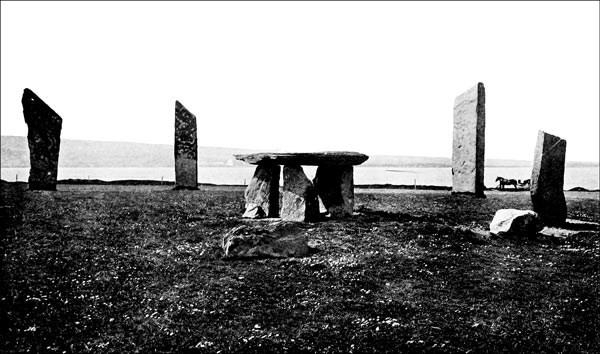
Valentine
THE RING OF STENNIS, ORKNEY (see page 94)
Among the archæological finds, which prove that the Easterners settled in Iberia before bronze working was introduced among the natives, are idol-like objects made of hippopotamus ivory from Egypt, a shell (Dentalium elephantum) from the Red Sea, objects made from ostrich eggs which must have been carried to Spain from Africa, alabaster perfume flasks, cups of marble and alabaster of Egyptian character which had been shaped with copper implements, Oriental painted vases with decorations in red, black, blue, and green,71 mural paintings on layers of plaster, feminine statuettes in alabaster which Siret considers to be of Babylonian type, for they differ from Ægean and Egyptian statuettes, a cult object (found in graves) resembling the Egyptian ded amulet, &c. The Iberian burial places of these Eastern colonists have arched cupolas and entrance corridors of Egyptian-Mycenæan character.
Of special interest are the beautifully worked flints associated with these Eastern remains in Spain and Portugal. Siret draws attention to the fact that no trace has been found of "flint factories". This particular flint industry was an entirely new one. It was not a development of earlier flint-working in Iberia. Apparently the new industry, which suddenly appears in full perfection, was introduced by the Eastern colonists. It afterwards spread over the whole maritime west, including Scandinavia where the metal implements of more advanced countries were imitated in flint. This important fact emphasizes the need for caution in making use of such a term as "Neolithic Age". Siret's view in this connection is that the Easterners, who established trading colonies in Spain and elsewhere, prevented the local use of metals which they had come to search for and export. It was part of their policy to keep the natives in ignorance of the uses to which metals could be put.
Evidence has been forthcoming that the operations of the Eastern colonies in Spain and Portugal were extended towards the maritime north. Associated with the Oriential relics already referred to, Siret has discovered amber from the Baltic, jet from Britain (apparently from Whitby in Yorkshire) and the green-stone called "callais" usually found in beds of tin. The Eastern seafarers must have visited Northern Europe to exploit its virgin riches. A green-stone axe was found, as has been stated, near the boat with the cork plug, which lay embedded in Clyde silt at Glasgow. Artifacts of callais have been discovered in Brittany, in the south of France, in Portugal, and in south-eastern Spain. In the latter area, as Siret has proved, the Easterners worked silver-bearing lead and copper.
The colonists appear to have likewise searched for and found gold. A diadem of gold was discovered in a necropolis in the south of Spain, where some eminent ancient had been interred. This find is, however, an exception. Precious metals do not as a rule appear in the graves of the period under consideration.
As has been suggested, the Easterners who exploited the wealth of ancient Iberia kept the natives in ignorance. "This ignorance", Siret says, "was the guarantee of the prosperity of the commerce carried on by the strangers.... The first action of the East on the West was the exploitation for its exclusive and personal profit of the virgin riches of the latter." These early Westerners had no idea of the use and value of the metals lying on the surface of their native land, while the Orientals valued them, were in need of them, and were anxious to obtain them. As Siret puts it:
"The West was a cow to be milked, a sheep to be fleeced, a field to be cultivated, a mine to be exploited."
In the traditions preserved by classical writers, there are references to the skill and cunning of the Phœnicians in commerce, and in the exploitation of colonies founded among the ignorant Iberians. They did not inform rival traders where they found metals. "Formerly", as Strabo says, "the Phœnicians monopolized the trade from Gades (Cadiz) with the islanders (of the Cassiterides); and they kept the route a close secret." A vague ancient tradition is preserved by Pliny, who tells that "tin was first fetched from Cassiteris (the tin island) by Midacritus".72 We owe it to the secretive Phœnicians that the problem of the Cassiterides still remains a difficult one to solve.
To keep the native people ignorant the Easterners, Siret believes, forbade the use of metals in their own colonies. A direct result of this policy was the great development which took place in the manufacture of the beautiful flint implements already referred to. These the natives imitated, never dreaming that they were imitating some forms that had been developed by a people who used copper in their own country. When, therefore, we pick up beautiful Neolithic flints, we cannot be too sure that the skill displayed belongs entirely to the "Stone Age", or that the flints "evolved" from earlier native forms in those areas in which they are found.
The Easterners do not appear to have extracted the metals from their ores either in Iberia or in Northern Europe. Tin-stone and silver-bearing lead were used for ballast for their ships, and they made anchors of lead. Gold washed from river beds could be easily packed in small bulk. A people who lived by hunting and fishing were not likely to be greatly interested in the laborious process of gold-washing. Nor were they likely to attach to gold a magical and religious value as did the ancient Egyptians and Sumerians.
So far as can be gathered from the Iberian evidence, the period of exploitation by the colonists from the East was a somewhat prolonged one. How many centuries it covered we can only guess. It is of interest to find, in this connection, however, that something was known in Mesopotamia before 2000 b.c. regarding the natural riches of Western Europe. Tablets have recently been found on the site of Asshur, the ancient capital of Assyria, which was originally a Sumerian settlement. These make reference to the Empire of Sargon of Akkad (c. 2600 b.c.), which, according to tradition, extended from the Persian Gulf to the Syrian coast. Sargon was a great conqueror. "He poured out his glory over the world", declares a tablet found a good many years ago. It was believed, too, that Sargon embarked on the Mediterranean and occupied Cyprus. The fresh evidence from the site of Asshur is to the effect that he conquered Kaptara (?Crete) and "the Tin Land beyond the Upper Sea" (the Mediterranean). The explanation may be that he obtained control of the markets to which the Easterners carried from Spain and the coasts of Northern Europe the ores, pearls, &c., they had searched for and found. It may be, therefore, that Britain was visited by Easterners even before Sargon's time, and that the Glasgow boat with the plug of cork was manned by dark Orientals who were prospecting the Scottish coast before the last land movement had ceased—that is, some time after 3000 b.c.
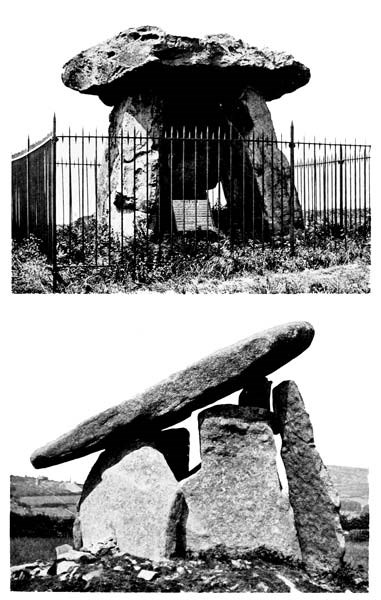
MEGALITHS
Upper: Kit's Coty House, Kent. Lower: Trethevy Stone, Cornwall.
When the Easterners were expelled from Spain by a people from Central Europe who used weapons of bronze, some of them appear to have found refuge in Gaul. Siret is of opinion that others withdrew from Brittany, where subsidences were taking place along the coast, leaving their megalithic monuments below high-water mark, and even under several feet of water as at Morbraz. He thinks that the settlements of Easterners in Brittany were invaded at one and the same time by the enemy and the ocean. Other refugees from the colonies may have settled in Etruria, and founded the Etruscan civilization. Etruscan menhirs resemble those of the south of France, while the Etruscan crozier or wand, used in the art of augury, resembles the croziers of the megaliths, &c., of France, Spain, and Portugal. There are references in Scottish Gaelic stories to "magic wands" possessed by "wise women", and by the mothers of Cyclopean one-eyed giants. Ammianus Marcellinus, quoting Timagenes,73 attributes to the Druids the statement that part of the inhabitants of Gaul were indigenous, but that some had come from the farthest shores and districts across the Rhine, "having been expelled from their own lands by frequent wars and the encroachments of the ocean".
The bronze-using peoples who established overland trade routes in Europe, displacing in some localities the colonies of Easterners and isolating others, must have instructed the natives of Western Europe how to mine and use metals. Bronze appears to have been introduced into Britain by traders. That the ancient Britons did not begin quite spontaneously to work copper and tin and manufacture bronze is quite evident, because the earliest specimens of British bronze which have been found are made of ninety per cent of copper and ten per cent of tin as on the Continent. "Now, since a knowledge of the compound", wrote Dr. Robert Munro, "implies a previous acquaintance with its component elements, it follows that progress in metallurgy had already reached the stage of knowing the best combination of these metals for the manufacture of cutting tools before bronze was practically known in Britain."74
The furnaces used were not invented in Britain. Professor Gowland has shown that in Europe and Asia the system of working mines and melting metals was identical in ancient times. Summarizing Professor Gowland's articles in Archæologia and the Journal of the Royal Anthropological Institute, Mr. W. J. Perry writes in this connection:75 "The furnaces employed were similar; the crucibles were of the same material, and generally of the same form; the process of smelting, first on the surface and then in the crucibles was found everywhere, even persisting down to present times in the absence of any fresh cultural influence. The study of the technique of mining and smelting has served to consolidate the floating mass of facts which we have accumulated, and to add support for the contention that one cultural influence is responsible for the earliest mining and smelting and washing of metals and the getting of precious stones and metals. The cause of the distribution of the megalithic culture was the search for certain forms of material wealth."



